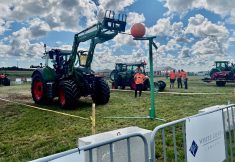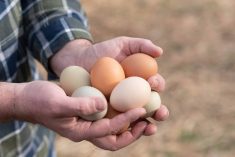By almost any measure, 2022 has been a tough year for most. Inflation, war, the growing consequences of climate change and then widening political divide are just a few of the compounding woes we continue to deal with.
In the middle of this chaos, however, U.S. farmers received remarkably good news. According to estimates released by the U.S. Department of Agriculture on Sept. 1, net farm income — what USDA describes as “a broad measure of profits” — for 2022 will rise $7.3 billion to hit a record $147.7 billion (all figures U.S.).
If accurate, that means U.S. net farm income will be up more than 54 per cent in the last two years.
Read Also

Introducing the purple tomato
Health Canada has approved bioengineered The Purple Tomato (TM), maybe leading to new culinary uses and health benefits?
The big difference between USDA’s 2021 income figures and its 2022 income forecast, however, is federal government payments to farmers. A year ago those dollars totalled a whopping $25.5 billion; in 2022 the payments totalled “only” $13 billion.
The USDA report came on the heels of an even-rosier 2021 farm income analysis of the 5,600 farm operators in the Illinois’ Farm Business Farm Management (FBFM) program issued earlier by the University of Illinois. That dive into actual 2021 farm records pegged the “average Illinois FBFM farm income” at a knee-buckling $433,386, an 80 per cent rise over 2020’s none-too-shabby $240,279.
[READ MORE] Over half Canada’s farm revenue now goes to biggest farms, census finds
The jet fuel for the rise came from two sources, according to the analysis: higher yields and higher prices. Together, the two raised actual per-acre average returns from 2020’s plump $861 to 2021’s fat $1,064.
And, yes, “average” means average; many FBFM farms showed higher incomes, others lower.
If you break the composite numbers out by farm enterprise, more surprises leap out. For example, FBFM hog farms earned an average 2021 net income of $780,000. That’s $360,000-plus more than the farms earned the year before.
Likewise, beef enterprises earned an average $494,143 in 2021, according to the records of the cooperative farm management service, or almost $50,000 more than the average Illinois grain farm.
And, no surprise given milk’s flat price last year, the net income across all FBFM dairy farms in Illinois was — by comparison — a piddling $162,267.
Coincidentally, another University of Illinois website, the popular and authoritative farmdocDaily, released the results of a farm policy survey Sept. 1 that queried “about 1,000 consumers about their views on inflation and whether the government should increase support for farmers and consumers facing higher prices.”
The results were as eye-popping as the Illinois net farm income numbers.
For example, most consumers — like most economists and politicians — are deeply split on what is responsible for today’s income-eating inflation. The survey’s most cited cause, “government policy,” led with 30 per cent. Closely behind, though, was COVID (22 per cent), corporate profits (15 per cent), and supply chain issues (15 per cent).
Not surprisingly, 57 per cent of respondents who identified themselves as “conservatives” blamed “government policy” for inflation compared to only 12 per cent who viewed themselves as “liberal.”
When the group was asked whether they “supported increases in funding for both food programs and farmers,” over 60 per cent — across “political ideologies” — said they did.
“Liberals had the highest rates of support for both,” according to the results, “with 90.2 per cent supporting increased funding for food programs and 85.3 per cent supporting increased funding for farmers.”
While “conservative” support in both areas was lower, the results still showed significant backing for increased funding for food programs — 64.4 per cent — and even higher support of 66.4 per cent for increased funding for farmers.
Maybe the most remarkable aspect of both sets of numbers — the sky-high 2021 average net farm incomes in Illinois and the surprisingly high support across the political spectrum for more government support for food aid and farmers — is the almost complete disconnect by consumers between the two.
I mean, what would the polling have shown if the more than 1,000 conservatives, liberals, and moderates surveyed were told that the average Illinois grain farmer earned a net income of $433,000 in 2021?
– The Farm & Food File is published weekly in newspapers throughout the U.S. and Canada. farmandfoodfile.com














